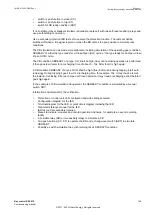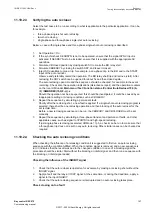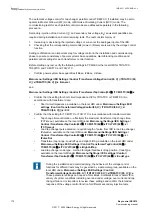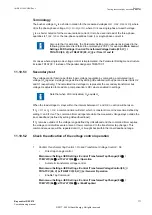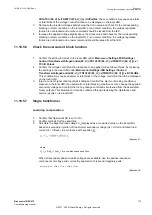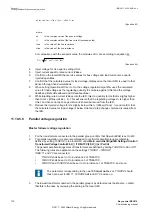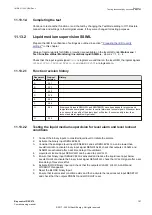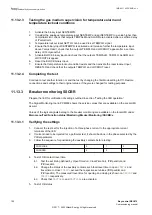
4.
Check that correct trip outputs, external signals, and indications are obtained for the actual type
of fault generated.
5.
Check that other zones operate according to their zone timers and that the send (CS) signal is
obtained only for the zone configured to generate the actual signal.
6.
Deactivate the receive (CR) signal in the IED.
7.
Check that the trip time complies with the zone timers and that correct trip outputs, external
signals, and indications are obtained for the actual type of fault generated.
11.11.1.3
Testing permissive overreaching
M13868-28 v4
1.
Activate the receive (CR) signal in the IED.
2.
Apply healthy normal load conditions to the IED for at least two seconds.
3.
Apply a fault condition within the permissive zone.
4.
Check that correct trip outputs, external signals, and indication are obtained for the actual type
of fault generated.
5.
Check that the other zones operate according to their zone timer and that the send (CS) signal
is obtained only for the zones that are configured to give the actual signal. Also the zone
connected to CS underreach is giving CS in this mode.
6.
Deactivate the IED receive (CR) signal.
7.
Apply healthy normal load conditions to the IED for at least two seconds.
8.
Apply a fault condition within the permissive zone.
9.
Check that trip time complies with the zone timers and that correct trip outputs, external
signals, and indications are obtained for the actual type of fault generated.
11.11.1.4
Testing blocking scheme
M13868-50 v5
1.
Deactivate the receive (CR) signal of the IED.
2.
Apply healthy normal load conditions to the IED for at least two seconds.
3.
Apply a fault condition within the forward directed zone used for scheme communication
tripping.
4.
Check that correct trip outputs and external signals are obtained for the type of fault generated
and that the operate time complies with the
tCoord
timer (plus relay measuring time).
5.
Check that the other zones operate according to their zone times and that a send (CS) signal is
only obtained for the reverse zone.
6.
Activate the IED receive (CR) signal.
7.
Apply a fault condition in the forward directed zone used for scheme communication tripping.
8.
Check that the no trip from scheme communication occurs.
9.
Check that the trip time from the forward directed zone used for scheme communication
tripping complies with the zone timer and that correct trip outputs, external signals, and
indications are obtained for the actual type of fault generated.
11.11.1.5
Testing delta blocking scheme
GUID-D5FF46AF-0C5A-4AD4-8F2C-09EC17B681F1 v2
1.
Deactivate the receive (CR) signal of the IED.
2.
Apply healthy normal load conditions to the IED for at least two seconds.
3.
Apply a fault condition within the forward directed zone used for scheme communication
tripping.
4.
Check that correct trip outputs and external signals are obtained for the type of fault generated
and that the operate time complies with the
tCoord
timer (plus relay measuring time).
5.
Check that the other zones operate according to their zone times and that a send (CS) signal is
only obtained for the reverse zone.
1MRK 511 403-UEN Rev. L
Section 11
Testing functionality by secondary injection
Bay control REC670
179
Commissioning manual
© 2017 - 2022 Hitachi Energy. All rights reserved
Содержание REC670
Страница 1: ...Relion 670 SERIES Bay control REC670 Version 2 2 IEC Commissioning manual ...
Страница 2: ......
Страница 28: ...22 ...
Страница 54: ...48 ...
Страница 60: ...54 ...
Страница 66: ...60 ...
Страница 90: ...84 ...
Страница 212: ...206 ...
Страница 218: ...212 ...
Страница 232: ...226 ...
Страница 240: ...234 ...
Страница 241: ...235 ...

